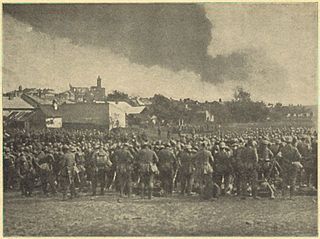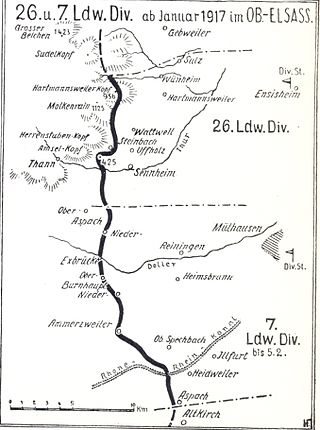
The 4th Landwehr Division was an infantry division of the Imperial German Army during World War I. It was formed on mobilization of the German Army in August 1914 under the "Higher Landwehr Commander 4". The Landwehr was the third category of the German Army, after the regular Army and the reserves. Thus Landwehr divisions were made up of older soldiers who had passed from the reserves, and were intended primarily for occupation and security duties rather than heavy combat. The division was primarily raised in the Prussian provinces of Upper and Lower Silesia. It was disbanded in 1919 during the demobilization of the German Army after World War I.
The 85th Landwehr Division was a unit of the Imperial German Army in World War I. The division was formed in November 1914 as the Breugel Division, named after its commander, Generalleutnant Willem Hendrick Clifford Kocq von Breugel, and became the 85th Landwehr Division on 13 September 1915. The division was disbanded in 1919 during the demobilization of the German Army after World War I. The Landwehr was the third category of the German Army, after the regular Army and the reserves. Thus Landwehr divisions were generally made up of older soldiers who had passed from the reserves, and were intended primarily for occupation and security duties rather than heavy combat.
The 5th Landwehr Division was a unit of the Imperial German Army in World War I. The division was formed in October 1914 as the Waldow Division, named after its commander. It was made up primarily of Landwehr soldiers from the garrison of Metz. It became the 5th Landwehr Division in January 1915. The division was disbanded in 1919 during the demobilization of the German Army after World War I.
The 2nd Bavarian Landwehr Division was a unit of the Bavarian Army, part of the Imperial German Army, in World War I. The division was formed on December 31, 1916. It was disbanded in 1919 during the demobilization of the German Army after World War I. It was composed primarily of troops of the Landwehr.
The 6th Bavarian Landwehr Division was a unit of the Bavarian Army, part of the Imperial German Army, in World War I. The division was formed on February 20, 1915. It was disbanded in 1919 during the demobilization of the German Army after World War I. It was composed primarily of troops of the Landwehr and the Landsturm from the 1st Bavarian Corps district.

The 10th Landwehr Division was a unit of the Imperial German Army in World War I.
The 12th Landwehr Division was a unit of the Imperial German Army in World War I.
The 13th Landwehr Division was a unit of the Imperial German Army in World War I.
The 14th Landwehr Division was a unit of the Imperial German Army in World War I.
The 15th Landwehr Division was a unit of the Prussian Army, part of Imperial German Army in World War I.
The 16th Landwehr Division was a unit of the Imperial German Army in World War I.
The 17th Landwehr Division was a unit of the Imperial German Army in World War I.
The 18th Landwehr Division was a unit of the Imperial German Army in World War I.
The 19th Landwehr Division was a unit of the Imperial German Army in World War I.
The 20th Landwehr Division was a unit of the Imperial German Army in World War I.
The 21st Landwehr Division was a unit of the Imperial German Army in World War I.
The 22nd Landwehr Division was a unit of the Imperial German Army in World War I.
The 23rd Landwehr Division was a unit of the Imperial German Army in World War I.
The 25th Landwehr Division was a unit of the Imperial German Army in World War I.

The 26th Landwehr Division was a unit of the Imperial German Army in World War I.


